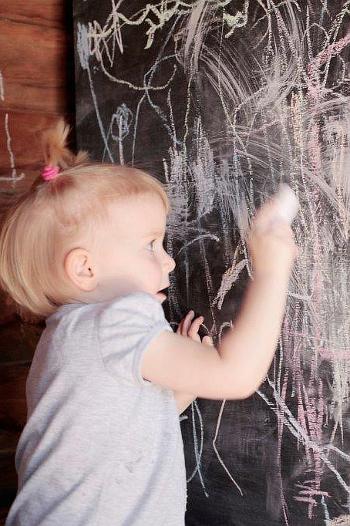Writing
Duration/age

Learning to write begins with children noticing writing around them and trying to create their own words.
You can help your child to begin to write by encouraging them to scribble and draw with a variety of tools and materials.
You could set up an area with drawing materials they can access at any time or encourage them to help you with everyday writing tasks.
We are going shopping tomorrow. Let’s write a list of what we need before we go.
Your brother is going on camp. You can help me to write labels for the clothes he will take.
Materials you will need
- Paper
- Pencils
- Sticky notepads
- Pens
Alternative tools
- Crayons
- Textas
- Notepads
Skills this activity improves
Why does this matter?
As you talk to your child about their drawings or the words and letters they have created they are beginning to understand that there is a connection between talking, writing and reading.
When children have plenty of opportunities to draw and write they are practising the skills they need to become skilled at writing.
They will also be learning that words and pictures have meaning and that the meaning is constant. If your child writes a word that you can read - like their name - they will learn that those letters together will always make that word.
When they draw a picture and they can describe it to you they are reading the picture - this is good practice for reading words.
What does this lead to?
When children have an opportunity to experiment with drawing and writing tools they are developing hand dominance (left hand vs right hand) and hand control.
This is important to enable children to write for extended periods of time and to create small detailed pictures. If a child has not developed good hand control they will tire quickly when writing, use their shoulder to move the hand rather than the wrist and will find it difficult to create small connected letters.
Engaging children in everyday writing activities like creating shopping lists or birthday cards provides children with the opportunity to develop social language and to learn how to take turns in a conversation. Developing rich oral language helps children to develop the skills and knowledge to be successful readers.
Language to use
- Word, letter, sentence, number
- Drawing, writing, picture, symbol, logo
- Recipe, list, letter, shopping list, label, tag
- Pen, pencil, texta, crayon
- Paper, notepad, whiteboard
Questions to use
- Can we write on things other than paper?
- Does all writing look the same?
- Can a picture represent a word?
- What is the difference between a logo, a picture and a word?
Useful tips
- When your child writes something, encourage them to read it back to you.
- When encouraging your child to write, start with simple words that they see a lot, like their own name or the names of other people in your family.
- Encourage your child to copy words that you have written. Point out letters that are in their own name or in the names of other people in your family.
- You might also like to take a look at the activities Making marks and Writing a letter or card.
- Remember to talk to your child in your home language.
More ideas
- Give your child a sticky notepad to write reminders for themselves.
- Make and write greeting cards together.
- Make words using magnetic letters and stick them on the fridge.
Variation by age
Three to five year olds
- Write a shopping list. Tick off the items as you buy or unpack them.
- Write your family messages on a board.
- Plan and write out your weekly menu together.
- Write captions in your family photo albums.
- Create labels for the new plants in the garden.
Questions to ask
- Does all writing go down the page?
- Why do some words start with a capital?
- How is a word different to a letter?


